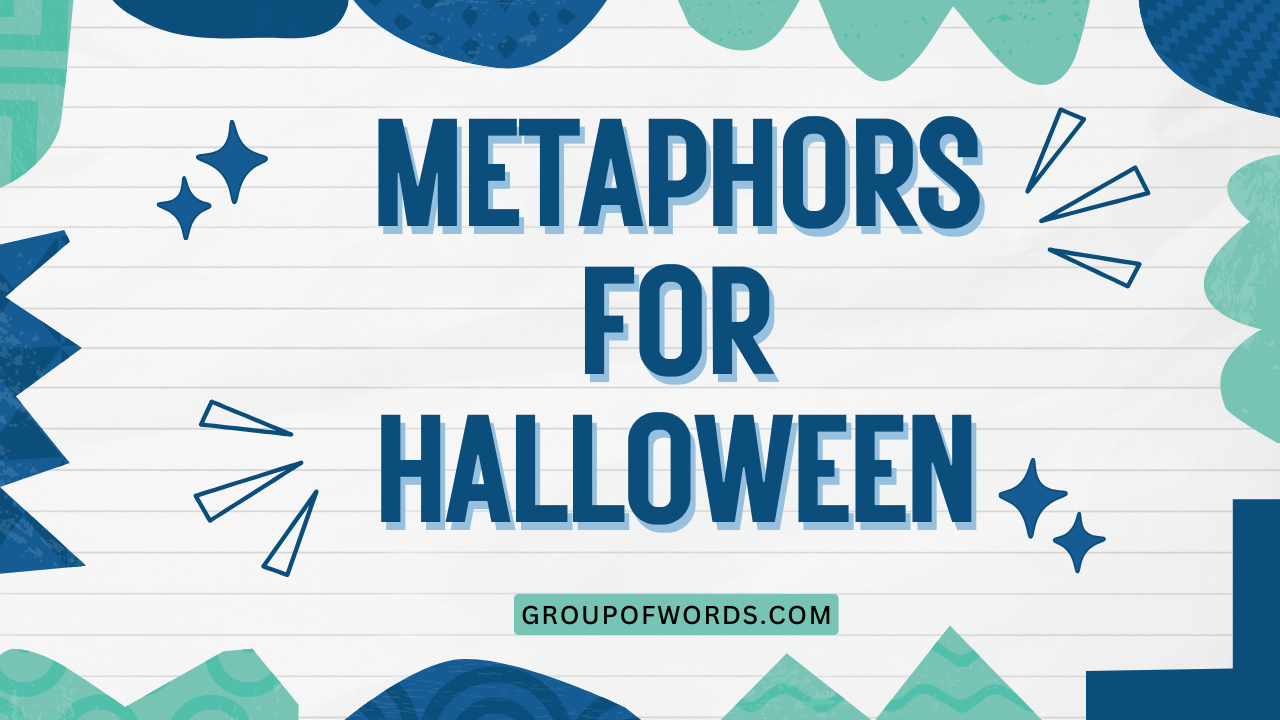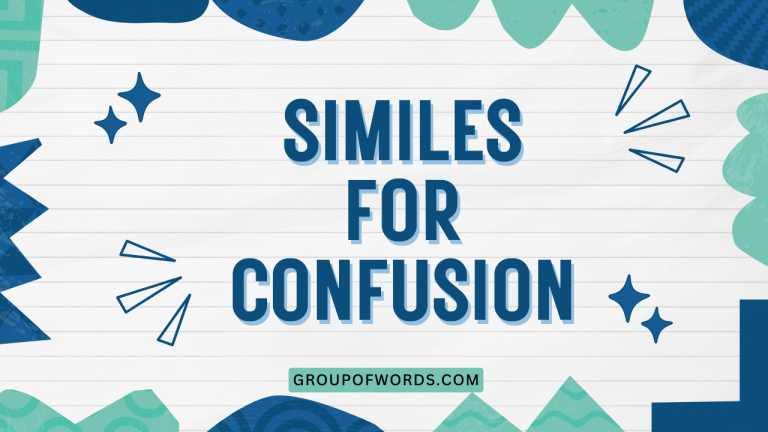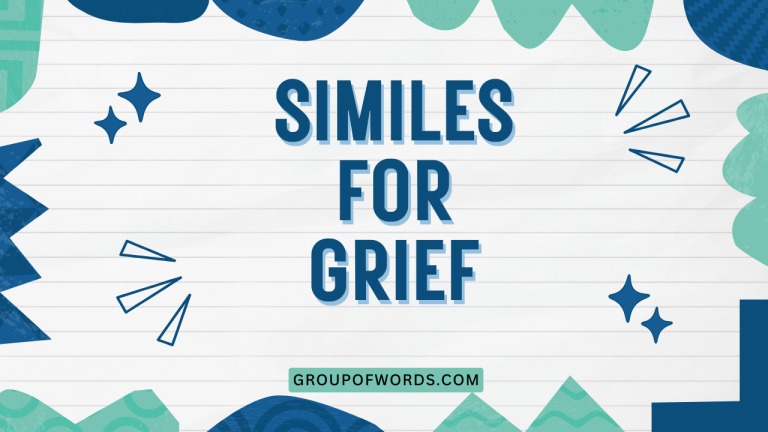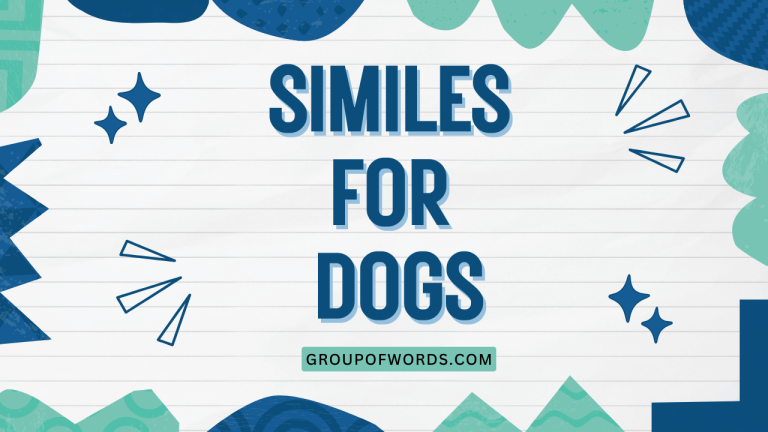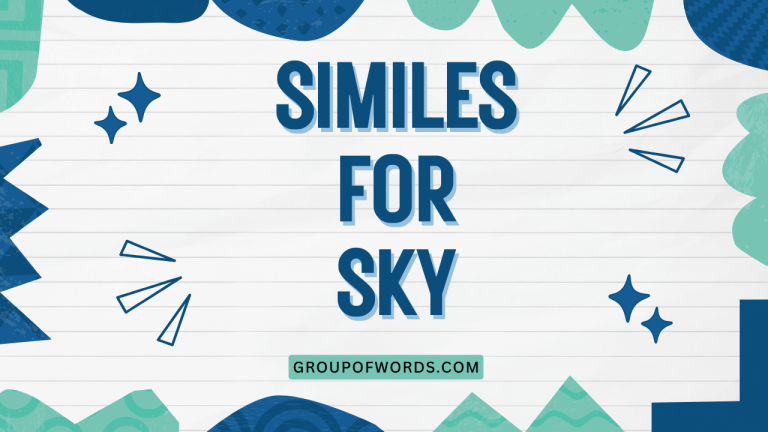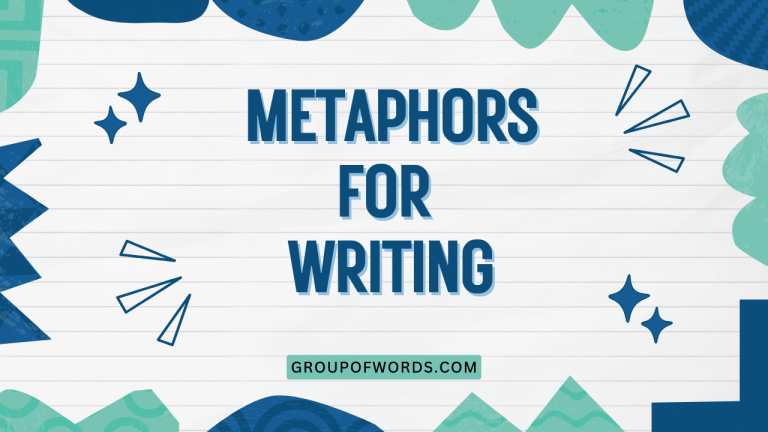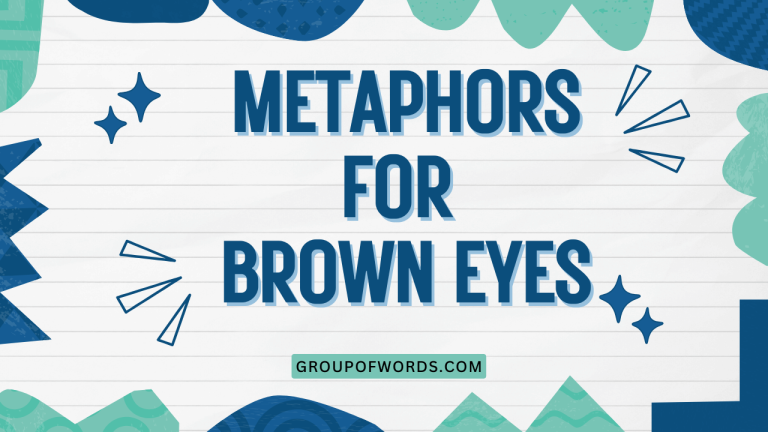Halloween Metaphors: Spooky Figures of Speech
Understanding metaphors is crucial for grasping nuanced language and enhancing creative expression. In English grammar, metaphors add depth and color to our communication, allowing us to convey complex ideas through imaginative comparisons.
Exploring metaphors, especially those associated with Halloween, not only enriches our vocabulary but also provides a fun and engaging way to master this essential literary device. This article is designed for English language learners, creative writers, and anyone interested in sharpening their understanding of figurative language.
This comprehensive guide will dissect Halloween metaphors, providing definitions, examples, usage rules, and practice exercises. Whether you’re preparing for an English exam, writing a spooky story, or simply looking to improve your linguistic skills, this article will equip you with the knowledge and tools to effectively use and interpret metaphors in various contexts.
Table of Contents
- Definition of Metaphor
- Structural Breakdown of Metaphors
- Types of Metaphors
- Halloween Metaphor Examples
- Usage Rules for Metaphors
- Common Mistakes with Metaphors
- Practice Exercises
- Advanced Topics in Metaphor Usage
- Frequently Asked Questions
- Conclusion
Definition of Metaphor
A metaphor is a figure of speech that directly compares two unrelated things without using “like” or “as.” It asserts that one thing *is* another, creating a vivid and often surprising connection in the reader’s mind. This comparison is not literal but imaginative, designed to highlight a shared quality or characteristic between the two subjects. Metaphors enrich language by adding layers of meaning and emotional resonance that literal language often lacks.
Metaphors are crucial in literature, poetry, and everyday conversation. They allow us to express abstract concepts in concrete terms, making them more accessible and relatable.
By understanding and using metaphors effectively, we can enhance our communication skills and deepen our appreciation for the power of language.
The primary function of a metaphor is to create a deeper understanding or emotional connection by transferring qualities from one thing to another. For example, saying “The haunted house was a tomb” suggests not only that the house was silent and gloomy but also that it was a place of death and decay, evoking a sense of dread and finality.
This goes beyond simply stating that the house was old or scary.
Classification and Function
Metaphors can be classified based on their explicitness and function. Some are direct and obvious, while others are subtle and implicit.
Their function can range from descriptive and evocative to persuasive and argumentative. Understanding these classifications helps in identifying and interpreting metaphors in different contexts.
Dead metaphors are metaphors that have become so common that they are no longer recognized as figurative language. Examples include “the heart of the matter” or “leg of the table.” They have lost their original imaginative force due to overuse.
Mixed metaphors combine two or more inconsistent metaphors, often creating a humorous or nonsensical effect. For instance, “We’ll burn that bridge when we get to it” combines the idea of burning a bridge (severing ties) with the idea of crossing a bridge (overcoming a challenge) in a contradictory way.
Structural Breakdown of Metaphors
A metaphor comprises two main elements: the tenor and the vehicle. The tenor is the subject being described, while the vehicle is the object or concept used to describe the tenor. The connection between the tenor and vehicle is the shared characteristic or quality that the metaphor highlights.
For example, in the metaphor “The full moon was a spectral eye,” the tenor is the “full moon,” and the vehicle is “a spectral eye.” The shared characteristic is the round shape and eerie glow, which evokes a sense of watching and being watched.
Understanding the relationship between the tenor and vehicle is essential for interpreting the meaning and impact of a metaphor. It allows us to analyze how the qualities of the vehicle are transferred to the tenor, creating a new and enriched understanding of the subject.
Identifying Tenor and Vehicle
To identify the tenor and vehicle in a metaphor, ask yourself: What is being described? (Tenor) What is it being compared to?
(Vehicle) Once you identify these elements, you can analyze the shared characteristics that make the metaphor effective.
Consider the metaphor: “The witch’s laughter was a cackling bonfire.” Here, the tenor is “witch’s laughter,” and the vehicle is “cackling bonfire.” The shared characteristics are the loud, crackling sound and the sense of uncontrolled, destructive energy.
Types of Metaphors
Metaphors can be categorized in several ways, depending on their directness, complexity, and purpose. Here are some common types:
- Standard Metaphors: Direct comparisons where the tenor and vehicle are clearly stated or implied.
- Implied Metaphors: The tenor is not explicitly stated but implied through the vehicle.
- Extended Metaphors: A metaphor that is developed over several lines or paragraphs, exploring the comparison in detail.
- Mixed Metaphors: The combination of two or more incompatible metaphors in a single expression.
Standard Metaphors
Standard metaphors are the most common type, where both the tenor and vehicle are easily identifiable. These metaphors are used to create a clear and immediate comparison.
Example: “The graveyard was a silent city.” (Tenor: graveyard; Vehicle: silent city)
Implied Metaphors
Implied metaphors are more subtle, as the tenor is not directly mentioned but inferred from the context. This type of metaphor requires the reader to make a connection between the vehicle and the unstated tenor.
Example: “The vampire stalked through the night, his shadow devouring the moonlight.” (Tenor: vampire; Vehicle: shadow devouring the moonlight – implies predatory nature)
Extended Metaphors
Extended metaphors are developed over a longer passage, exploring various aspects of the comparison. This type of metaphor allows for a more detailed and nuanced understanding of the subject.
Example: “Halloween night is a canvas, painted with shadows and illuminated by the flickering smiles of jack-o’-lanterns. Each costume is a brushstroke, adding color and character to the scene.
The night unfolds like a story, each house a chapter, each encounter a plot twist.”
Mixed Metaphors
Mixed metaphors combine two or more inconsistent metaphors, often resulting in a humorous or confusing effect. While sometimes unintentional, mixed metaphors can be used deliberately for comedic effect.
Example: “Let’s nip this problem in the bud and iron out the wrinkles before they hatch.” (Combines “nip in the bud,” “iron out the wrinkles,” and “hatch” in an inconsistent way.)
Halloween Metaphor Examples
Halloween provides a rich source of metaphorical language, drawing on themes of fear, mystery, transformation, and the supernatural. Here are some examples of Halloween metaphors, categorized by theme:
Fear and Dread
Halloween often evokes feelings of fear and dread, and metaphors can effectively capture these emotions. These metaphors often use imagery of darkness, monsters, and decay to create a sense of unease and suspense.
The following table provides examples of metaphors that evoke fear and dread, with explanations of their intended meaning.
| Metaphor | Explanation |
|---|---|
| The haunted house was a tomb. | Compares the house to a place of death and confinement, emphasizing its eerie and lifeless atmosphere. |
| Fear was a cold hand gripping his heart. | Describes the sensation of fear as a physical force, emphasizing its intensity and control. |
| The graveyard was a city of stone silence. | Highlights the stillness and desolation of the graveyard, suggesting a place where life has ceased. |
| The werewolf’s howl was a scream of primal terror. | Evokes the raw, untamed fear associated with the werewolf and its wild nature. |
| The fog was a ghostly shroud, enveloping the town. | Compares the fog to a burial cloth, creating a sense of impending doom and mystery. |
| Her eyes were bottomless pits, reflecting the abyss. | Suggests a profound emptiness and darkness within the person, hinting at hidden depths of despair or evil. |
| The creaking door was the voice of forgotten souls. | Imbues the door with a supernatural quality, suggesting that it is a conduit for ghostly communication. |
| The shadow was a predator, stalking the hallway. | Personifies the shadow as a dangerous and menacing presence, creating a sense of unease. |
| The silence was a heavy blanket, suffocating the room. | Describes the oppressive nature of the silence, suggesting that it is stifling and uncomfortable. |
| The anticipation was a coiled snake, ready to strike. | Creates a sense of suspense and impending danger, suggesting that something terrible is about to happen. |
| His face was a mask of terror. | Compares his expression to a mask, indicating that his fear is so intense that it has transformed his features. |
| The darkness was a hungry beast, devouring the light. | Personifies the darkness as a powerful and destructive force, emphasizing its ability to consume and overwhelm. |
| The wind was a mournful wail, echoing through the trees. | Imbues the wind with a sense of sadness and loss, creating a melancholic atmosphere. |
| The spiderweb was a trap woven from nightmares. | Suggests that the spiderweb is not just a physical object but also a symbol of fear and entrapment. |
| The skeleton’s grin was a mocking invitation to death. | Personifies the skeleton’s grin as a sinister gesture, emphasizing the inevitability of death. |
| The potion was a brew of dark secrets. | Suggests that the potion contains hidden and sinister knowledge, implying danger and mystery. |
| The night was a canvas of eerie shadows. | Presents the night as a backdrop filled with unsettling and mysterious shapes, enhancing the spooky atmosphere. |
| Each step was a journey into the heart of darkness. | Emphasizes the growing sense of dread and the descent into a terrifying situation. |
| The air hung heavy with the scent of decay. | Creates a palpable sense of rot and death, contributing to the overall atmosphere of horror. |
| His heart pounded like a drum of impending doom. | Illustrates the intense fear and anxiety experienced, comparing it to a rhythmic and ominous beat. |
| The old house was a repository of forgotten horrors. | Portrays the house as a place filled with past tragedies and terrifying memories. |
| The forest whispered secrets only the brave dared to hear. | Personifies the forest as a source of hidden and potentially dangerous knowledge. |
| The candles flickered like dying breaths. | Compares the fading light of the candles to the last moments of life, adding a sense of fragility and mortality. |
Transformation and Disguise
Halloween is a time of transformation and disguise, where people dress up as different characters and identities. Metaphors can capture this sense of change and deception.
The following table provides examples of metaphors related to transformation and disguise, with explanations of their meanings.
| Metaphor | Explanation |
|---|---|
| The costume was a mask, hiding her true self. | Compares the costume to a disguise, emphasizing its ability to conceal one’s true identity. |
| He was a chameleon, blending into the Halloween crowd. | Compares the person to a chameleon, highlighting their ability to adapt and blend into their surroundings. |
| The makeup was a canvas, transforming her face into a monster. | Compares the makeup to an art form, emphasizing its ability to create a dramatic transformation. |
| The night was a masquerade, where everyone played a role. | Compares Halloween night to a masked ball, suggesting that everyone is acting out a part. |
| He shed his identity like a snake sheds its skin. | Compares the act of changing identity to the shedding of skin, emphasizing the complete and transformative nature of the change. |
| The mask was a portal to another persona. | Suggests that wearing the mask allows the person to step into a different identity or character. |
| She wore her confidence like a borrowed costume. | Indicates that her confidence is not genuine but rather something she is pretending to possess. |
| The transformation was a metamorphosis, from human to creature. | Compares the transformation to a biological process, emphasizing the profound and fundamental nature of the change. |
| His disguise was a shield, protecting him from judgment. | Suggests that the disguise allows him to hide from the scrutiny and expectations of others. |
| The costume was a second skin, allowing him to explore a different side of himself. | Indicates that the costume provides an opportunity for self-discovery and exploration. |
| She was a blank slate, ready to be painted with a new identity. | Compares her to a blank canvas, suggesting that she is open to adopting a new persona. |
| His voice was a chameleon, shifting to match his character. | Highlights his ability to alter his voice to suit the role he is playing. |
| The costume was a key, unlocking a hidden part of his personality. | Suggests that the costume allows him to express aspects of himself that are usually suppressed. |
| She was a shape-shifter, adapting to every situation. | Compares her to a mythical creature, emphasizing her ability to change and adapt. |
| His true self was buried beneath layers of makeup and pretense. | Indicates that his true identity is hidden and obscured by his disguise. |
| The costume was a mirror, reflecting a different version of himself. | Suggests that the costume reveals a new perspective on his own identity. |
| He donned his character like a suit of armor. | Portrays the character as a protective layer, shielding him from vulnerability. |
| Her smile was a mask, concealing her true feelings. | Indicates that her smile is deceptive and hides her real emotions. |
| The transformation was a rebirth, shedding the old and embracing the new. | Compares the transformation to a new beginning, emphasizing the opportunity for growth and change. |
| His costume was a disguise, allowing him to walk among the monsters unnoticed. | Suggests that the costume allows him to blend in with the supernatural elements of Halloween. |
| The mask was a shield, guarding his vulnerability. | Portrays the mask as a form of protection, concealing his insecurities. |
| He was a master of disguise, slipping effortlessly into each new role. | Highlights his skill in adopting different identities convincingly. |
| The costume was a portal, transporting him to a world of imagination. | Suggests that the costume allows him to escape reality and enter a realm of fantasy. |
Supernatural and Mystical
Halloween is associated with the supernatural and mystical, and metaphors can effectively capture this sense of otherworldliness.
The following table provides examples of metaphors related to the supernatural and mystical, with explanations of their meanings.
| Metaphor | Explanation |
|---|---|
| The witch’s brew was a cauldron of secrets. | Compares the brew to a repository of hidden knowledge and mysteries. |
| The ghosts were whispers of the past, haunting the present. | Compares the ghosts to echoes of past events, suggesting their lingering influence on the present. |
| The spell was a web, ensnaring its victims. | Compares the spell to a trap, emphasizing its ability to capture and control. |
| The cemetery was a garden of souls, blooming in the moonlight. | Presents the cemetery as a place of beauty and serenity, where souls find peace. |
| The séance was a bridge between worlds, connecting the living and the dead. | Compares the séance to a means of communication between different realms of existence. |
| Her intuition was a compass, guiding her through the darkness. | Suggests that her intuition provides direction and clarity in uncertain situations. |
| The prophecy was a riddle, waiting to be solved. | Compares the prophecy to a puzzle, emphasizing its mysterious and enigmatic nature. |
| The amulet was a shield against evil, protecting its wearer. | Portrays the amulet as a form of defense against negative forces. |
| The ritual was a dance, performed in harmony with the cosmos. | Compares the ritual to a coordinated movement, suggesting its connection to the universe. |
| The oracle was a fountain of wisdom, dispensing ancient knowledge. | Presents the oracle as a source of profound insight and understanding. |
| The incantation was a key, unlocking the doors of magic. | Suggests that the incantation provides access to supernatural powers. |
| The dream was a portal, transporting her to another realm. | Compares the dream to a gateway to a different dimension of experience. |
| The shadow was a doppelganger, mirroring her every move. | Suggests that the shadow is a second self, reflecting her actions. |
| The curse was a chain, binding her to a tragic fate. | Compares the curse to a form of imprisonment, limiting her freedom. |
| The enchantment was a veil, obscuring the truth. | Suggests that the enchantment hides or distorts reality. |
| The potion was a elixir, granting immortality. | Compares the potion to a solution that grants eternal life. |
| The moon was a silent guardian, watching over the haunted land. | Presents the moon as a protector of the supernatural and eerie environment. |
| The spirits were echoes, resonating through the ages. | Compares the spirits to lingering sounds from the past, emphasizing their enduring presence. |
| The crystal ball was a window, offering glimpses into the future. | Suggests that the crystal ball provides insights into what is yet to come. |
| The ceremony was a tapestry, woven with ancient traditions. | Compares the ceremony to a complex artwork, highlighting its rich cultural heritage. |
| The warlock’s power was a storm, raging within him. | Portrays the warlock’s abilities as a powerful and uncontrollable force. |
| The spellbook was a library, filled with arcane knowledge. | Compares the spellbook to a collection of esoteric information. |
| The potion was a key, unlocking hidden abilities. | Suggests that the potion grants access to latent talents. |
Usage Rules for Metaphors
Using metaphors effectively requires careful consideration of context, clarity, and consistency. Here are some guidelines to follow:
- Ensure Clarity: The connection between the tenor and vehicle should be clear and understandable.
- Maintain Consistency: Avoid mixing metaphors that create illogical or confusing comparisons.
- Consider Audience: Choose metaphors that resonate with your audience and enhance their understanding.
- Avoid Clichés: Steer clear of overused metaphors that have lost their impact and originality.
Clarity and Relevance
A good metaphor should enhance understanding, not obscure it. Ensure that the connection between the tenor and vehicle is clear and relevant to the context.
If the metaphor is too obscure or far-fetched, it may confuse the reader rather than enlighten them.
For example, instead of saying “His anger was a hurricane,” which is a common cliché, you could say “His anger was a sudden squall, tearing through his composure,” which provides a more specific and vivid image.
Consistency and Logic
Mixing metaphors can create illogical and confusing comparisons. Ensure that your metaphors are consistent and coherent within the same passage.
Avoid combining metaphors that clash or contradict each other.
Incorrect: “Let’s grab the bull by the horns and swim upstream.” (Mixing “grab the bull by the horns” and “swim upstream”)
Correct: “Let’s grab the bull by the horns and tackle this challenge head-on.”
Audience and Context
Consider your audience and the context in which you are using the metaphor. Choose metaphors that resonate with your audience’s knowledge and experience.
A metaphor that works in one context may not be effective in another.
For example, a metaphor that uses technical jargon may be appropriate for a specialized audience but confusing for a general audience.
Common Mistakes with Metaphors
Using metaphors incorrectly can lead to confusion or unintended humor. Here are some common mistakes to avoid:
- Using Clichéd Metaphors: Overusing common metaphors that have lost their impact.
- Mixing Metaphors: Combining inconsistent metaphors in a single expression.
- Creating Unclear Comparisons: Using metaphors that are too obscure or difficult to understand.
- Misunderstanding the Connotation: Failing to consider the emotional associations of the vehicle.
Below is a table illustrating common mistakes with metaphors. The table shows incorrect usages and then the corrected version.
| Incorrect | Correct | Explanation |
|---|---|---|
| He was a fish out of water in the haunted house. | He felt like a fish out of water in the haunted house. | The original sentence is a cliché. The corrected sentence uses “felt like” to indicate a comparison, making it more effective. |
| Let’s put all our eggs in one basket and grab the low-hanging fruit. | Let’s focus our efforts on grabbing the low-hanging fruit. | The original sentence mixes “put all our eggs in one basket” and “grab the low-hanging fruit.” The corrected sentence uses a single, consistent metaphor. |
| The ghost’s presence was a purple elephant in the room. | The ghost’s presence was an elephant in the room. | The original sentence uses an unclear comparison. The corrected sentence uses a more common and understandable metaphor. |
| Her smile was a ray of sunshine in the dark, cold dungeon. | Her smile was a ray of sunshine in the gloomy dungeon. | The original sentence uses redundant imagery. The corrected sentence simplifies the comparison for greater impact. |
| The vampire’s eyes were burning ice. | The vampire’s eyes were like burning ice. | The original sentence presents a contradictory comparison. The corrected sentence uses “like” to soften the contrast. |
| The werewolf’s howl was a symphony of silence. | The werewolf’s howl shattered the silence. | The original sentence is an oxymoron that doesn’t quite work. The corrected sentence provides a clearer contrast. |
| The witch’s laughter was a sweet poison. | The witch’s laughter was like sweet poison. | The original sentence is confusing. The addition of “like” makes it a simile. |
| The graveyard was a silent disco. | The graveyard was eerily silent. | The original sentence is an incongruous comparison. The corrected sentence uses a more appropriate and direct description. |
| The zombie’s walk was a graceful storm. | The zombie’s walk was a shambling mess. | The original sentence uses a nonsensical comparison. The corrected sentence provides a more accurate and vivid description. |
| His fear was a warm blanket on a cold night. | His fear was an icy grip on his heart. | The original sentence is inappropriate. The corrected sentence uses a more fitting comparison. |
| The spiderweb was a free ticket to heaven. | The spiderweb was a sticky trap. | The original sentence is nonsensical. The corrected sentence uses a more logical comparison. |
| The haunted house was a playground of joy. | The haunted house was a playground of fear. | The original sentence is inappropriate. The corrected sentence uses a more fitting comparison. |
| Her scream was a gentle whisper. | Her scream was a piercing shriek. | The original sentence is an oxymoron that doesn’t quite work. The corrected sentence provides a clearer contrast. |
| The potion was a fountain of youth in a bottle. | The potion promised a fountain of youth. | The original sentence is a cliché. The corrected sentence uses a more subtle and effective comparison. |
| The mask was a window to his soul. | The mask was a shield for his soul. | The original sentence is contradictory. The corrected sentence uses a more logical comparison. |
| His lies were honey dripping from his lips. | His lies were poison dripping from his lips. | The original sentence is inappropriate. The corrected sentence uses a more fitting comparison. |
| The darkness was a comforting hug. | The darkness was a suffocating blanket. | The original sentence is inappropriate. The corrected sentence uses a more fitting comparison. |
| The silence was a loud roar. | The silence was deafening. | The original sentence is an oxymoron that doesn’t quite work. The corrected sentence provides a clearer description. |
| The wind was a gentle giant. | The wind was a howling beast. | The original sentence is inappropriate. The corrected sentence uses a more fitting comparison. |
Practice Exercises
Test your understanding of Halloween metaphors with these exercises:
Exercise 1: Identifying Metaphors
Identify the metaphors in the following sentences and explain their meaning:
- The old house was a skeleton against the moonlit sky.
- Fear was a shadow, clinging to her heels.
- The witch’s voice was a rusty gate creaking open.
- The graveyard was a peaceful garden, slumbering under the stars.
- His costume was a suit of confidence, transforming his demeanor.
- The potion was a key, unlocking hidden powers.
- The haunted forest was a labyrinth of dread.
- Her eyes were pools of moonlight, reflecting ancient secrets.
- The vampire’s charm was a velvet trap.
- The night was a black cat, slinking through the streets.
Answers:
- The old house was a skeleton against the moonlit sky. (Metaphor: house = skeleton; Meaning: emphasizes the bare, decaying structure of the house.)
- Fear was a shadow, clinging to her heels. (Metaphor: fear = shadow; Meaning: describes fear as a constant, inescapable presence.)
- The witch’s voice was a rusty gate creaking open. (Metaphor: voice = rusty gate; Meaning: suggests a harsh, grating, and unsettling sound.)
- The graveyard was a peaceful garden, slumbering under the stars. (Metaphor: graveyard = peaceful garden; Meaning: presents the graveyard as a place of rest and tranquility.)
- His costume was a suit of confidence, transforming his demeanor. (Metaphor: costume = suit of confidence; Meaning: suggests that the costume gives him a sense of self-assurance.)
- The potion was a key, unlocking hidden powers. (Metaphor: potion = key; Meaning: implies that the potion grants access to abilities that were previously dormant.)
- The haunted forest was a labyrinth of dread. (Metaphor: forest = labyrinth; Meaning: describes the forest as a confusing and frightening place.)
- Her eyes were pools of moonlight, reflecting ancient secrets. (Metaphor: eyes = pools of moonlight; Meaning: suggests that her eyes hold deep, mysterious knowledge.)
- The vampire’s charm was a velvet trap. (Metaphor: charm = velvet trap; Meaning: indicates that his charm is alluring but ultimately dangerous.)
- The night was a black cat, slinking through the streets. (Metaphor: night = black cat; Meaning: describes the night as mysterious, stealthy, and slightly ominous.)
Exercise 2: Creating Metaphors
Create your own Halloween metaphors for the following subjects:
- A jack-o’-lantern
- A ghost
- A witch’s hat
- A haunted house
- A skeleton
- A vampire
- A werewolf
- A graveyard
- A potion
- A mask
Example Answers:
- A jack-o’-lantern: A grinning sun, casting eerie light.
- A ghost: A whisper of memory, floating through time.
- A witch’s hat: A cone of shadow, concealing dark thoughts.
- A haunted house: A museum of fear, displaying ghostly exhibits.
- A skeleton: A map of mortality, revealing the bones of life.
- A vampire: A predator in disguise, cloaked in elegance.
- A werewolf: A beast within, unleashed by the moon’s pull.
- A graveyard: A city of silence, tenanted by dreams.
- A potion: A liquid secret, promising transformation.
- A mask: A canvas of deception, hiding the true self.
Exercise 3: Correcting Mixed Metaphors
Correct the following mixed metaphors:
- Let’s grab the bull by the horns and swim upstream.
- He was skating on thin ice while burning the candle at both ends.
- She was a diamond in the rough, but she needed to nip it in the bud.
- He was a fish out of water, but he decided to bite the bullet.
- They were barking up the wrong tree while hitting the nail on the head.
- The project was a rollercoaster, and they needed to keep their eye on the ball.
- The idea was a seed, and they needed to run with it.
- They were crossing that bridge when it rained cats and dogs.
- He was a lone wolf, and they needed to think outside the box.
- It’s not rocket science, but we need to iron out the kinks.
Answers:
- Let’s grab the bull by the horns and tackle this challenge head-on.
- He was skating on thin ice and taking unnecessary risks.
- She was a diamond in the rough, but she needed polishing.
- He was a fish out of water, and he felt uncomfortable.
- They were barking up the wrong tree and wasting their time.
- The project was a rollercoaster, and they needed to stay focused.
- The idea was a seed, and they needed to nurture it.
- They were crossing that bridge when they encountered unexpected problems.
- He was a lone wolf, and they needed to respect his independence.
- It’s not rocket science, but we need to work out the details.
Advanced Topics in Metaphor Usage
For advanced learners, exploring the philosophical and psychological aspects of metaphors can deepen their understanding and appreciation. Metaphors are not just linguistic devices but also cognitive tools that shape our thinking and perception.
Conceptual Metaphors
Conceptual metaphors are underlying cognitive structures that shape our understanding of abstract concepts. They involve mapping one domain of experience onto another, allowing us to reason about complex ideas in more concrete terms.
Example: “ARGUMENT IS WAR” (e.g., “He attacked my argument,” “I defended my position”)
The Role of Metaphors in Cognition
Metaphors play a crucial role in shaping our thoughts, emotions, and actions. They influence how we perceive and interact with the world around us.
By understanding the power of metaphors, we can become more aware of our own cognitive biases and assumptions.
For instance, if we view “TIME IS MONEY,” we may be more inclined to value efficiency and productivity, and feel anxious about wasting time.
Frequently Asked Questions
- What is the difference between a metaphor and a simile?
A metaphor directly equates two unlike things without
using “like” or “as,” while a simile uses “like” or “as” to make a comparison. For example, “The haunted house was a tomb” (metaphor) vs. “The haunted house was like a tomb” (simile).
- How can I avoid using clichéd metaphors?
To avoid clichés, try to think of fresh and original comparisons that capture the essence of what you’re trying to describe. Use vivid imagery and sensory details to make your metaphors more impactful.
- What is the best way to identify a metaphor in a text?
Look for statements that assert one thing is another, even though they are not literally the same. Ask yourself if the comparison is meant to be taken literally or figuratively.
- Can metaphors be used in formal writing?
Yes, but use them sparingly and thoughtfully. Metaphors can add depth and nuance to formal writing, but they should be used judiciously to avoid sounding too informal or subjective.
- How do metaphors enhance creative writing?
Metaphors add layers of meaning, evoke emotions, and create vivid images in the reader’s mind. They can transform ordinary descriptions into something extraordinary.
Conclusion
Metaphors are powerful tools for enhancing communication, fostering creativity, and deepening understanding. By mastering the art of using metaphors, you can enrich your language skills, express complex ideas more effectively, and engage your audience on a deeper level.
Whether you’re writing spooky Halloween stories or simply looking to improve your command of English, understanding metaphors is an invaluable asset.
Continue to practice and explore different types of metaphors to refine your skills and develop your own unique voice. Happy writing, and may your words always be as enchanting as a moonlit Halloween night!
